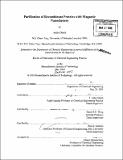Purification of recombinant proteins with magnetic nanoclusters
Author(s)
Ditsch, Andre (Andre Paul)
DownloadFull printable version (15.60Mb)
Other Contributors
Massachusetts Institute of Technology. Dept. of Chemical Engineering.
Advisor
T. Alan Hatton and Daniel I.C. Wang.
Terms of use
Metadata
Show full item recordAbstract
This thesis focused on the development and analysis of a new class of magnetic fluids for recovery of recombinant proteins from fermentation broth. Magnetic fluids are colloidally stable dispersions of magnetic nanoclusters in water that do not settle gravitational and moderate magnetic fields due to their small size. The magnetic nanoclusters possess large surface area for protein adsorption without any porous structure, resulting in much faster mass transfer than in traditional separations. The magnetic nanoclusters consist of 25-200 nm clusters of 8 nm magnetite (Fe₃0₄) cores coated with poly(acrylic acid-co-styrenesulfonic acid-co-vinylsulfonic acid). For use in separation, clusters must be recoverable from solution. Individual nanoparticles are too small to be recovered efficiently, while 50nm or larger clusters of primary particles are easily recovered. Cluster size depends on polymer molecular weight and hydrophobicity as well as the amount of polymer present at nucleation. When a polymer coating with optimal molecular weight is used in limited amounts, clusters are formed. When the clusters are subsequently coated with additional polymer, the clusters are stable in high ionic strength environments (>5M NaCl), while retaining the necessary cluster size for efficient magnetic recovery. (cont.) Models have been developed to predict the optimal molecular weight, and the cluster size obtained with limited amounts of polymer or polymers other than the optimal molecular weight. The models and methods have been verified with other polymer coatings, indicating that the methods can be used to synthesize a wide range of stable nanoclusters. Due to rapid mass transfer, the rate-limiting step of the purification scheme is recovery of the nanoclusters from solution with high gradient magnetic separation (HGMS). The nanoclusters can be recovered extremely efficiently, up to 99.9% at high flow rates, up to 10,000 cm/hr. A detailed model of HGMS has been developed to quantitatively predict capture, and simpler methods have been developed to predict the maximum capture and capacity of the column without computationally expensive simulations. The use of the nanoclusters for protein purification was studied both with model proteins the recombinant protein drosomycin from Pichia pastoris fermentation broth. The nanoclusters have high adsorptive capacities of up to 900 mg protein/mL adsorbent, nearly an order of magnitude higher than the best commercially available porous adsorbents. Adsorption can be performed both by ion exchange and hydrophobic interactions, allowing nearly pure drosomycin to be recovered from clarified fermentation broth in a single step. (cont.) When used in whole cell broth, the nanoclusters bind to proteins on the surface of the Pichia pastoris cells at conditions where drosomycin is bound, limiting the effectiveness of the separation. When proteins are bound at conditions where nanoclusters do not bind to cells, cell clarification and protein purification can be performed in one fast step. A simple model of the cell binding has been developed, providing guidelines for use of magnetic nanoparticles in the presence of cells.
Description
Thesis (Ph. D.)--Massachusetts Institute of Technology, Dept. of Chemical Engineering, 2005. Includes bibliographical references.
Date issued
2005Department
Massachusetts Institute of Technology. Department of Chemical EngineeringPublisher
Massachusetts Institute of Technology
Keywords
Chemical Engineering.